Turnitin Draft Coach provides you with the ability to use Turnitin’s tools in your Google Docs to help you work towards the final draft of your assignment before you submit to your teacher.
Turnitin Draft Coach is still in Beta, which means we will be continuing to make improvements to it. You may notice some changes to the side panel on the right, and if you are unsure what they are or how they can help, you can check back here anytime!
Similarity Report
If instances are found where a user's writing is similar to or matches against a source in our database this will be flagged for your review in the Turnitin Draft Coach side panel.
The database includes billions of web pages: both current and archived content from the Internet, a database of student papers that have been submitted to Turnitin in the past, and a collection of documents, which consists of thousands of periodicals, journals, and publications.
Interpreting the report
The percentage of the similarity score is based on the amount of matching text in a document. It is perfectly natural for an assignment to match against some of our databases. If you've used quotes and referenced correctly, there will be instances where we will find a match and that is totally OK! The similarity score simply highlights any matching areas in your paper so your teacher can use this as an investigative tool to determine if the match is or is not acceptable. Each matching source is color-coded and listed numerically to make it easier to distinguish between multiple matches.

There are two parts to your Similarity Report:
-
Match - This is text that is very similar or the same as some text you have in your Google Doc. Your matches are highlighted in your Google Doc and the colors will correlate with the sources listed in your insight panel.
-
Source - The source is where a particular match has been found. This can be a webpage, a student paper, or a published journal. Your sources are listed numerically in your insight panel and it is possible to have multiple matches for each source. Selecting one of your sources will reveal information like how many matches were found for that particular source and where each match was found on that web page, student paper, or journal.
What can I do with the information in the report?
The information in your Turnitin Similarity Report should help you make decisions about how to improve your writing, whether that is in later drafts of the same assignment or on future assignments of a different nature. If you have the opportunity to revise your writing based on your Similarity Score, consider the following:
-
choose only the most significant quotes to include from your sources
-
summarize, paraphrase, or explain an idea in your own words rather than quoting it directly
-
cite all of your evidence using the appropriate citation style
What is a ‘good’ or ‘bad’ similarity score?
Turnitin does not set a similarity percentage that you should try to avoid or achieve. However, your school or teacher may have assigned a certain number as the acceptable threshold for assignments at your school. Consult your teacher for details on this threshold. Some similarity is usually expected and can simply mean that you have included source-based evidence which is a requirement for some assignments. If you have concerns or questions regarding any aspect of your similarity score, your teacher will be able to advise you.
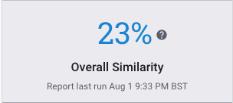
Don’t forget, you have a total of three reports that you can run for your draft. If your similarity score is higher than you would like, take a look at the highlighted matches and see where you can improve, and then run your report again when you are finished revising your first draft.
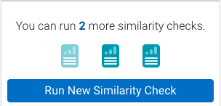
Citations Check
The Citations Check is used to help you identify when your citations are missing references or when your references are missing citations. This check focuses on identifying matching pairs of citations and references that you include in your text.
Interpreting the report
Your citations report will detect the number of citations, references, and the citation style that has been used in your draft. The number of citations should always be equal to or more than the number of references.
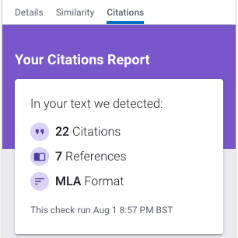
There are two Issues that a Citation Report will list if they are found:
-
Citation with no reference - Every citation should have a corresponding reference listed within your bibliography
-
Reference with no citation - Every reference in your bibliography should have at least one corresponding citation within your draft assignment
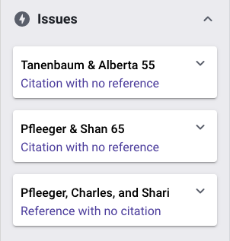
Note: The citations report will not catch any sources that have neither a citation nor a reference. This would likely be shown in the Similarity Report as a match in our database.
All References will provide you with a list of the references within your bibliography. With each reference, it will display how many citations are linked to it. If the number of citations is 0, a purple, lightening Issue badge will appear on the reference to draw your attention to it. Citations with no corresponding reference will also be listed here, along with the page number of where it is located and an Issue badge.
What is the difference between a citation and a reference?
Citations and references are closely related but refer to two different pieces of information that should appear in your work.
-
A citation is a mention of a source within your text. Citations are usually included within parentheses brackets with note information like author, date of publication, or page number where the information can be found. The information within citations differs depending on which citation style you are using.
-
A reference is a description of each source that you use within your text. References are listed at the end of your document in alphabetical order and include information like author, source title, publisher, date of publication, etc. The information within references differs depending on which citation style you are using.
What can I do with the information in the report?
Use the information in your Citations Check to inform changes that you should make in your draft. Consider the following when viewing your Citations Check results:
-
All evidence must be cited using the appropriate citation style. Consult with your teacher to determine which style is preferred.
-
Each reference listed in your bibliography should have matching citations within your text.
-
Likewise, each citation within your text should have a matching reference listed in your bibliography.
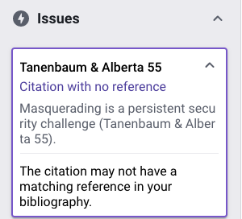
Was this page helpful?
We're sorry to hear that.
